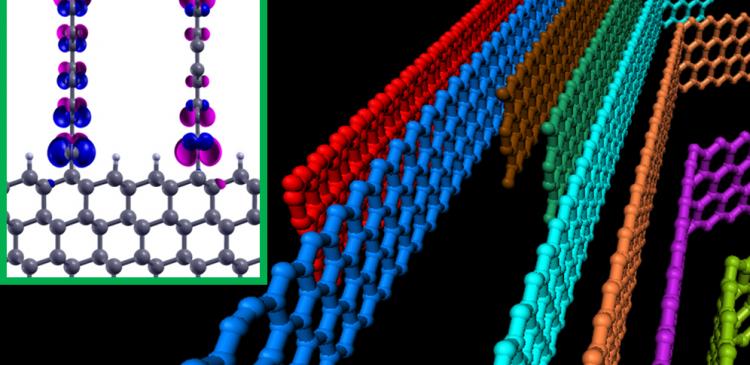According to Dr Ding (right) and Dr Hu of PolyU, graphene is the naturally synthesized thinnest fabric that owes both the highest flexibility and extreme strength (about 100 times stronger than steel).
The study of graphene has become a hot topic after two scientists based in Manchester received the Nobel Prize in Physics for their ground-breaking research last year. More recently, researchers of The Hong Kong Polytechnic University (PolyU) have achieved further breakthrough in studying graphene on the nano-scale.
The latest study by Dr Feng Ding, Dr Hong Hu of PolyU and Professor Boris Yakobson of Rice University in the US have shown that even tiny strips of graphene – one-atom-thick sheets of carbon – can stand tall on a substrate with a little support of certain materials such as diamond or metal for binding strips of graphene nanoribbon. This opens the door of investigation for using arrays of graphene walls as ultra-high density components of electronic devices with a wide range of potential applications. This finding was published in the online edition of the Journal of the American Chemical Society.
According to Dr Ding and Dr Hu, who are now an Assistant Professor and Associate Professor respectively, of PolyU’s Institute of Textile and Clothing, graphene is the naturally synthesized thinnest fabric that owes both the highest flexibility and extreme strength (about 100 times stronger than steel). The exceptional electronic properties of graphene and its very high thermal conductivity make this material an ideal candidate for flexible and wearable electronic applications. It is expected to have a profound impact on future design of smart textiles and E-textiles.
The research has illustrated the differences between walls made of two distinct types of graphene nanoribbons, zigzag and armchair, so-called because of the way their edges are shaped. The nanoribbons would be able to stand easily at a 90-degree angle, and the walls could then be grown as close as 7/10ths of a nanometer. It is very surprising that these standing graphene preserve nearly all its intriguing electronic and magnetic properties and thus can be sued as freestanding ones. This research thus lays the groundwork for subnanometre electronic technology.
The work has paved the way for the study of graphene walls on a nano-scale with nearly all of their inherent electrical or magnetic properties retained. They estimated a theoretical potential of putting 100 trillion graphene wall field-effect transistors (FETs) on a single chip which merely measures square-inch. Their work would in effect extend the Moore’s Law by another 10 years.




